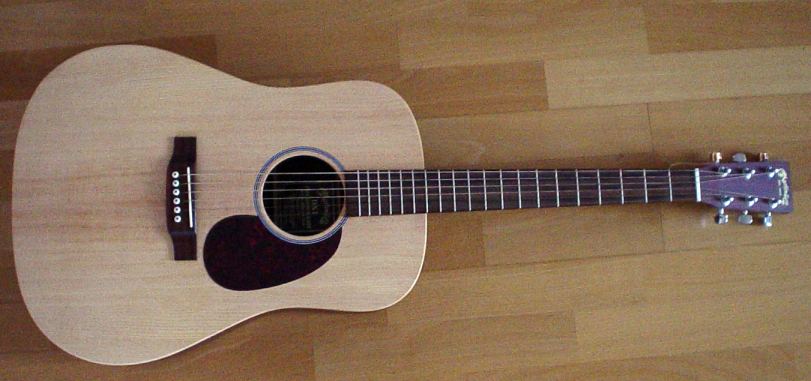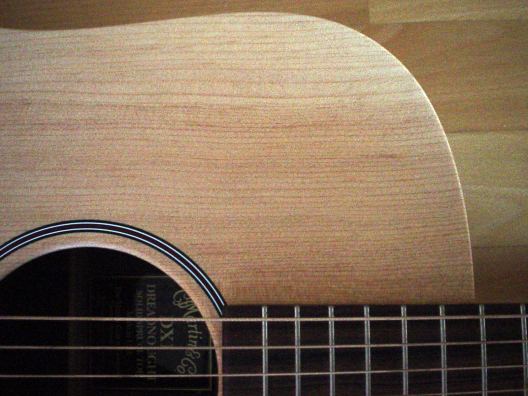C.F. Martin Model "DX-1" Custom

This is how the Martin DX-1 looked when it was new - so sah sie neu aus
...

and this is, how it looks now, after I had a herringbone purfling and an
ivoroid binding built in.
So sah sie aus, nachdem eine Herringbone-Randeinlage und Ivoroid-Binding
eingebaut waren.
You can see the whole customizing procedure here....
Hier ist die gesamte Individualisierungs-Prozedur zu verfolgen.....
This is the least expansive Martin dreadnought guitar with a solid spruce top.It sounds like a dreadnought should: Loud and clear with lots of low end. The guitar is made of some materials unusual from the traditional luthier's point of view, it is a good sounding and playable instrument. It's a low end guitar, when it comes to fancy things. The guitar has no binding around the top, no fretboard inlays and the finish is not polished at all. Some day the idea came to my mind to have the guitar customized. Now the top is surrounded by the traditional herringbone trim and a bright ivoroid binding. Top and sides are polished to high gloss. The appearance of the guitar has totally changed this way. It looks cool and I had the opportunity to gather some more guitar building and customizing experience.
This is how it is built:
Top: Solid Sitka Spruce
Back & Sides High pressure laminat ("HPL").
Neck: Something called "stratobond",
seems to be multi-layer plywood
Fretboard and Bridge
Rosewood
Bindings: Herringbone purfling and ivoroid
binding - I had the guitar customized
Soundhole sorrounded by three line plastic inlay
Headstock logo: Golden Letters.
Neck width at Nut: 43,5
mm (a bit more than 1-11/16).
String spacing at nut: 38 mm (almost
1-1/2")
Scale Length: 25,4" (645,15 mm).
C. F. Martin in Nazareth, Pennsyvania claims to be the oldest comapny building guitars (or at least steel string guitars) today. The company was established in the year 1833 by Christian Frederick Martin, a German immigrant to the USA, born in Markneukirchen Germany. The company is still owned and held by a family member. Today chairman is Christian Frederick Martin IV, the 6th boss in the company's history. Martin is said to be the inventor of the dreadnought guitar. Among steel string guitars about 80-90 % have the form and size of a dreadnought. The Martin DX-1 is the low end model with a solid spruce top and a body made laminate that should also work well as an office floor surface. The purflings and finish are kept simple or are even left away in order to offer a quality instrument for an affordable price. The top is braced with a newer kind of "X"-bracing called the "A-Frame". The Martin DX-1 has a lot of bass punch, soft treble and an overall mellow yet strong sound. Surprisingly it is a nice fingerpicking guitar (at least for a dreadnought size guitar) because it features a good attack.
The top wood definitely not shows the straight an narrow grain one would expect from a high end or more expansive guitar. But the top produces a nice sound and that's all it should do with this instrument.
Dies ist die preisgünstigste Martin Dreadnought, die man mit solider Holzdecke bekommen kann. Obwohl sie im Hinblick auf äußere Verzierungen "Low-end" ist, ist sie ein vollwertiges Musikinstrument mit einem sehr schönen Dreadnought-Klang. Viel Baß und Lautstärke und eine gute Bespielbarkeit bis in die hohen Lagen.
Sie ist folgendermassen gebaut:
Decke: Sitkafichte massiv
Boden & Zargen
Hochdruck-Laminat ("HPL")
Hals: Etwas, das sich "Stratobond"
schimpft, aber wie vielschichtiges Sperrholz aussieht
Griffbrett, Brücke und Kopfplattenfurnier: Palisander
Korpuseinfassungen: gibts ned.
Schallocheinfassung: Plastik-Einlage in
Ringform
Logo auf Kopfplatte: Goldfarbene Buchstaben auflackiert
Halsbreite am Sattel: 43,5
mm
Saitenabstand am Sattel: 38 mm
Mensur: 645,15 mm (25,4")

before....
after